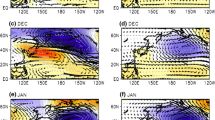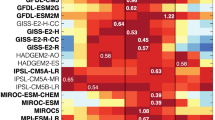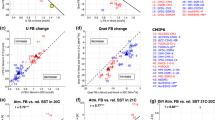Abstract
The change in the teleconnections of both El Niño and La Niña over the North Pacific and American regions due to a future greenhouse warming has been analyzed herein by means of diagnostics of the Intergovernmental Panel on Climate Change-Fourth Assessment Report (IPCC-AR4) coupled general circulation models (CGCMs). Among the IPCC-AR4 CGCM simulations, the composites of the eight-member multimodel ensemble are analyzed. In most CGCMs, the tropical Pacific warming due to the increase of CO2 concentration in the atmosphere promotes the main convection centers in the equatorial Pacific associated with both El Niño and La Niña to the east. The eastward shift of the convection center causes a systematic eastward shift of not only El Niño but also La Niña teleconnection patterns over the North Pacific and America, which is demonstrated in the composite maps of 500 hPa circulation, surface temperature, and the precipitation against El Niño and La Niña, as observed in a comparison between the pre-industrial and CO2 doubling experiments. Thus, a systematic eastward migration of convection centers in the tropical Pacific associated with both El Niño and La Niña due to a future global warming commonly causes the eastward shift of the atmospheric teleconnection patterns over the Northern Hemisphere.





Similar content being viewed by others
References
An S-I, Jin F-F (2000) An eigen analysis of the interdecadal changes in the structure and frequency of ENSO mode. Geophy Res Lett 27:1573–1576
An S-I, Wang B (2000) Interdecadal change of the structure of the ENSO mode and its impact on the ENSO frequency. J. Climate 13:2044–2055
An S-I, Ye Z, Hsieh WW (2006) Changes in the leading ENSO modes associated with the late 1970s climate shift: role of surface zonal current. Geophy Res Lett 33:L14609. doi:10.1029/2006GL026604
An S-I, Kug J-S, Timmermann A, Kang I-S, Timm O (2007) The influence of ENSO on the generation of decadal variability in the North Pacific. J Climate 20:667–680
An S-I, Kug J-S, Ham Y-G, Kang I-S (2008) Successive modulation of ENSO to the future greenhouse warming. J Climate 21:3–21
Boer GJ, Yu B (2003a) Dynamical aspects of climate sensitivity. Geophys Res Lett 30:1135. doi:10.1029/2002GL016549
Boer GJ, Yu B (2003b) Climate sensitivity and response. Climate Dyn 20:415–429
Boer GJ, Yu B, Kim SJ, Flato GM (2004) Is there observational support for an El Niño-like pattern of future global warming? Geophys Res Lett 31:L06201. doi:10.1029/2003GL018722
Cane M, Clement AC, Kaplan A, Kushnir Y, Pozdnyakov D, Seager R, Zebiak S, Murtugudde R (1997) Twentieth century sea surface temperature trends. Science 275:957–960
Collins M (2000a) Understanding uncertainties in the response of ENSO to greenhouse warming. Geophy Res Lett 27:3509–3513
Collins M (2000b) The El Niño–Southern Oscillation in the second Hadley centre coupled model and its response to greenhouse warming. J Climate 13:1299–1312
Cubasch U, Meehl GA, Boer GJ, Stouffer RJ, Dix M, Noda A, Senior CA, Raper S, Yap KS (2001) Projections of future climate change. In: Houghton JT, Ding Y, Griggs DJ, Noguer M, van der Linden P, Dai X, Maskell K, Johnson CL (eds) Climate change 2001: the scientific basis. Contribution of Working Group I to the Third Assessment Report of the Intergovernmental Panel on Climate Change. Cambridge University Press, New York, pp 525–582
Guilyardi E (2006) El Niño-mean state–seasonal cycle interactions in a multi-model ensemble. Clim Dyn 26:329–348
Hoerling MP, Kumar A, Zhong M (1997) El Niño, La Niña, and the nonlinearity of their teleconnections. J Clim 10:1769–1786
Kang I-S, Kug J-S (2002) El Niño and La Niña sea surface temperature anomalies: asymmetry characteristics associated with their wind stress anomalies. J Geophy Res 107(D19):4372. doi:10.1029/2001JD000393
Knutson TR, Manabe S (1995) Time-mean response over the tropical Pacific due to increased CO2 in a coupled ocean-atmosphere model. J Climate 8:2181–2199
Knutson TR, Manabe S (1998) Model assessment of decadal variability and trends in the tropical Pacific Ocean. J Climate 11:2273–2296
Liu Z, Vavrus S, He F, Wen N, Zhong Y (2005) Rethinking tropical ocean response to global warming: the enhanced equatorial warming. J Climate 18:4684–4700
Meehl GA, Teng H (2007) Multi-model changes in El Niño teleconnections over North America in a future warmer climate. Climate Dyn 29:779–790
Meehl GA, Washington WM (1996) El Niño-like climate change in a model with increased atmospheric CO2 concentrations. Nature 382:56–60
Meehl GA, Teng H, Branstator GW (2006) Future changes of El Niño in two global coupled climate models. Clim Dyn 26:549–566
Merryfield W (2006) Changes to ENSO under CO2 doubling in a multi-model ensemble. J Clim 19:4009–4027
Müller WA, Roeckner E (2006) ENSO impact on midlatitude circulation patterns in future climate change projections. Geophys Res Lett 33:L05711. doi:10.1029/2005GL025032
Rein B, Lückge A, Sirocko F (2004) A major Holocene ENSO anomaly during the Medieval period. Geophy Res Let 31:L17211. doi:10.1029/2004GL020161
Ropelewski CF, Halpert MS (1987) Global and regional scale precipitation patterns associated with the El Niño/Southern Oscillation. Mon Wea Rev 115:1606–1626
Sterl A, van Oldenborgh GJ, Hazeleger W, Burgers G (2007) On the robustness of ENSO teleconnections. Clim Dyn 29:469–485. doi:10.1007/s00382-007-0251-z
Timmermann A, Oberhuber J, Bacher A, Esch M, Latif M, Roeckner E (1999) Increased El Niño frequency in a climate model forced by future greenhouse warming. Nature 398:694–696
Vavrus S, Liu Z (2002) Understanding the response of the tropical atmosphere-ocean system to increased CO2 using Equilibrium Asynchronous Coupling. Climate Dyn 19:355–369
Wang B, An S-I (2001) Why the properties of El Niño changed during the late 1970s. Geophy Res Lett 28:3709–3712
Yu B, Boer GJ (2002) The roles of radiation and dynamic processes in the El Niño-like response to global warming. Climate Dyn 19:539–553
Zhang Y, Wallace JM, Battisti DS (1997) ENSO-like interdecadal variability: 1900–93. J Climate 10:1004–1020
Acknowledgments
We acknowledge the modeling groups for providing their data for analysis, the Program for Climate model Diagnosis and Intercomparison for collecting and archiving the model output, and the JSC/CLIVAR Working Group on Coupled Modeling for organizing the model data analysis activity. The multimodel data archive is supported by the Office of Science, US Department of Energy. This research was supported by “National Comprehensive Measures against Climate Change” Program by Ministry of Environment, Korea (grant no. 1600-1637-301-210-13), and Brain Korea 21 Project. J.-S. Kug is supported by KORDI (PE98417, PP00720).
Author information
Authors and Affiliations
Corresponding author
Rights and permissions
About this article
Cite this article
Kug, JS., An, SI., Ham, YG. et al. Changes in El Niño and La Niña teleconnections over North Pacific–America in the global warming simulations. Theor Appl Climatol 100, 275–282 (2010). https://doi.org/10.1007/s00704-009-0183-0
Received:
Accepted:
Published:
Issue Date:
DOI: https://doi.org/10.1007/s00704-009-0183-0




